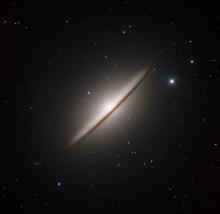A dark lane of dust outlines the disk of Messier 104, giving the galaxy a festive nickname: the Sombrero. The galaxy is about 30 million light-years away, in Virgo. It has a bright “bulge” of stars in the middle, and a lane of dark dust around its rim. The galaxy has a central black hole that’s roughly 250 times the mass of the Milky Way’s black hole. It appears to be “feeding” on massive amounts of gas, perhaps funneled in from outside the galaxy. Stars are being born in a ring of dust along the dark rim.
[ESO/IDA/Danish 1.5 m/R. Gendler and J.-E. Ovaldsen]
You are here
Sombrero Galaxy
The Sombrero Galaxy has taught us a lot. It provided important details about the birth, scale, and evolution of the universe. And it’s a good laboratory for studying the birth of stars and the feeding habits of giant black holes.
The Sombrero is about 30 million light-years away. It forms a disk that we see almost edge-on. It has a bright “bulge” of stars in the middle, and a lane of dark dust around its rim. That makes it look like a sombrero.
In 1912, V.M. Slipher discovered that the galaxy is moving away from us at about 25 million miles per hour. At the time, astronomers were debating whether the entire universe was contained inside the Milky Way. Slipher’s discovery indicated that the Sombrero was a separate galaxy, far beyond the Milky Way. It also suggested that the universe was expanding.
The galaxy has a central black hole that’s roughly 250 times the mass of the Milky Way’s black hole. It appears to be “feeding” on massive amounts of gas, perhaps funneled in from outside the galaxy.
Stars are being born in the galaxy’s ring of dust. Studying that process can tell astronomers more about how stars are born — all from the “brim” of a galactic sombrero.
The Sombrero is in Virgo. The Moon is passing through the constellation tonight, with Virgo’s leading light, Spica, close to its upper right. The Sombrero is about the same distance to the lower right of Spica, and is an easy target for telescopes.
Script by Damond Benningfield
Get Premium Audio
Listen to today's episode of StarDate on the web the same day it airs in high-quality streaming audio without any extra ads or announcements. Choose a $8 one-month pass, or listen every day for a year for just $30.







